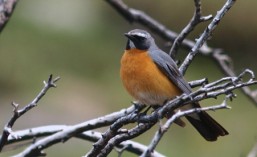One of the major differences between bird watching back home on the Faroes and Turkey is the raptors. On the Faroes I’ve seen less than 10 species of raptors, but in Turkey I’ve seen 24 raptor species – and the last one was added to the list yesterday.
I took the 20 minutes drive to Mogan just to spend a few hours in the field. The first ting I noticed was the wast numbers of starlings present. I have no idea how many there were, but my guess is 100.000 or more. And such numbers attrack raptors.
After two hours I had seen several Marsh Harriers, Long-legged Buzzards, Steppe Buzzards, two Hen Harriers, a Peregrine Falcon, a few Merlins, several Kestrels – all of them doing their best to catch the starlings. What a sight it is to see the starlings move as if controlled by a single mind!
All of a sudden I see a large falcon chasing the starlings. At first I thought it was a juvenile Peregrine, but then it passed a Long-legged Buzzard and I realised that it was enormous. It came a little closer and I noticed white head, brown upper parts, very contrasting underwings, brown belly extending to the feet – YES!!! SAKER FALCON!
The bird was moving very fast as it was chasing a small flock of starlings, so I jumped out of the car (which I had used as a hide in order to get closer to the starlings) and I managed to get some very distant shots – but good enough to document the bird.
Saker Falcon is a rare breeder in Turkey and mostly found in mountains, so seeing one at Mogan was a huge surprise. I’ve talked to Emin and other birders, and this might be the first record of this species at Mogan. And actually this was my first lifer in 2012!
Silas Olofson


























































